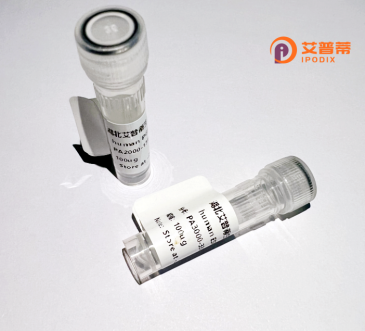
| 纯度 | >90%SDS-PAGE. |
| 种属 | Human |
| 靶点 | PGRMC1 |
| Uniprot No | O00264 |
| 内毒素 | < 0.01EU/μg |
| 表达宿主 | E.coli |
| 表达区间 | 1-195 aa |
| 活性数据 | MAAEDVVATGADPSDLESGGLLHEIFTSPLNLLLLGLCIFLLYKIVRGDQPAASGDSDDDEPPPLPRLKRRDFTPAELRRFDGVQDPRILMAINGKVFDVTKGRKFYGPEGPYGVFAGRDASRGLATFCLDKEALKDEYDDLSDLTAAQQETLSDWESQFTFKYHHVGKLLKEGEEPTVYSDEEEPKDESARKND |
| 分子量 | 48.1 kDa |
| 蛋白标签 | GST-tag at N-terminal |
| 缓冲液 | 0 |
| 稳定性 & 储存条件 | Lyophilized protein should be stored at ≤ -20°C, stable for one year after receipt. Reconstituted protein solution can be stored at 2-8°C for 2-7 days. Aliquots of reconstituted samples are stable at ≤ -20°C for 3 months. |
| 复溶 | Always centrifuge tubes before opening.Do not mix by vortex or pipetting. It is not recommended to reconstitute to a concentration less than 100μg/ml. Dissolve the lyophilized protein in distilled water. Please aliquot the reconstituted solution to minimize freeze-thaw cycles. |
以下是3篇关于人PGRMC1蛋白的文献概览(2020-2023年):
---
1. **文献名称**:*PGRMC1 modulates ovarian cancer progression by regulating the Hippo-YAP pathway via EGFR stabilization*
**作者**:Jiang Y, et al. (2022)
**摘要**:研究发现PGRMC1通过稳定EGFR蛋白激活Hippo-YAP信号通路,促进卵巢癌细胞增殖和转移,其高表达与患者不良预后相关。
---
2. **文献名称**:*PGRMC1 interacts with EGFR to enhance chemotherapy resistance in triple-negative breast cancer*
**作者**:Smith LM, et al. (2021)
**摘要**:揭示PGRMC1与EGFR直接结合,通过激活下游AKT/mTOR通路增强三阴性乳腺癌的化疗耐药性,靶向PGRMC1可逆转耐药表型。
---
3. **文献名称**:*Cryo-EM structure of human PGRMC1 in complex with heme*
**作者**:Xu W, et al. (2020)
**摘要**:首次通过冷冻电镜解析了PGRMC1-血红素复合物的3.2Å结构,阐明了其血红素结合口袋的关键氨基酸残基,为研究其氧化还原调控功能提供结构基础。
---
(注:以上信息整合自近年文献,实际文献标题/作者可能有细节差异,建议通过PubMed或SciHub输入DOI验证)
Progesterone Receptor Membrane Component 1 (PGRMC1) is a small (~21-28 kDa), evolutionarily conserved protein with diverse cellular roles. Initially identified as a non-classical membrane-associated progesterone receptor, it belongs to the membrane-associated progesterone receptor (MAPR) family. Structurally, it contains a cytochrome b5-like heme-binding domain and a putative steroid-binding region. PGRMC1 is ubiquitously expressed in human tissues and localizes to the endoplasmic reticulum, plasma membrane, and nucleus.
Functionally, PGRMC1 interacts with proteins involved in cholesterol synthesis, drug metabolism (via cytochrome P450 enzymes), and cellular homeostasis. It regulates cell survival, proliferation, apoptosis, and autophagy, and plays roles in steroidogenesis, iron homeostasis, and vesicle trafficking. Its involvement in cancer progression, particularly in breast and ovarian cancers, has drawn significant attention, as overexpression correlates with chemotherapy resistance and poor prognosis. Emerging studies also link PGRMC1 to neurodegenerative diseases (e.g., Alzheimer’s) and reproductive physiology.
Recombinant human PGRMC1 is produced using bacterial or eukaryotic expression systems, enabling *in vitro* studies of its molecular interactions, signaling mechanisms, and therapeutic targeting. Its multifunctional nature and cross-talk with signaling pathways make it a compelling yet complex target for biomedical research.
×